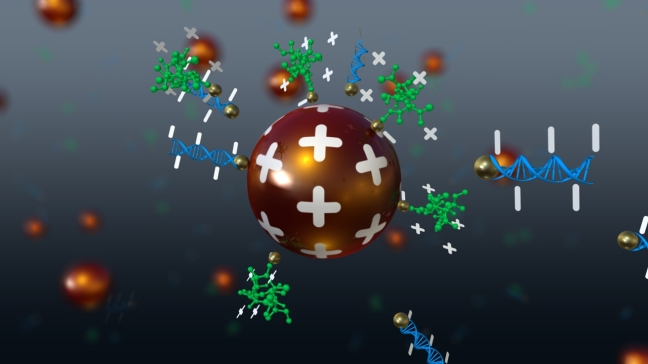Nanoparticles can be efficiently conjugated to biomolecules forming hybrid compounds termed nano-bio-conjugates. The nanoparticle core, in this case, consists of a noble metal, predominantly gold, and the ligand shell can be made of peptides, proteins, antibodies or oligonucleotides. The bonds between biomolecule and nanoparticle are mostly formed by Au-thiol chemistry. In this context, ligand-free nanoparticles from laser synthesis are particularly useful as they are free from organic stabilizers which minimizes toxic cross effects and furthermore grants a high surface coverage and a precise control of ligand/nanoparticle ratios. Nano-bio-conjugates can be used for: 
- Imaging and as contrast agents (e.g. in vitro diagnostics)
- Drug delivery (e.g. photo-induced release)
- Targeting (e.g. pathological protein aggregates)
- Cellular transfection (e.g. in regulatory T-cells)
Our main research goals and interests are:
- Conjugate design for monovalent (only one ligand type) and bivalent (two different ligand types) systems fitted to the needs of a partner from biology and medicine
- Optimization of ligand load and conjugation efficiency in correlation with colloidal stability
- Evaluation of functionality and colloidal stability of the conjugates in relevant biological media, in in vitro and in vivo assays and finally in the clinic.
References:
[1] Stein, F.; Schielke, A.; Barcikowski, S.; Rehbock, C. Influence of Gold/Silver Ratio in Ablative Nanoparticles on Their Interaction with Aptamers and Functionality of the Obtained Conjugates. Bioconjugate Chemistry (2021), 32, 2439-2446.
[2] L. Gamrad, R. Mancini, D. Werner, D. Tiedemann, U. Taylor, A. Ziefuss, C. Rehbock, S. Klein, W. Kues, S. Barcikowski, D. Rath, Triplex-hybridizing bioconjugated gold nanoparticles for specific Y-chromosome sequence targeting of bull spermatozoa, Analyst, 142 (2017) 2020-2028.
[3] L. Gamrad, C. Rehbock, A.M. Westendorf, J. Buer, S. Barcikowski, W. Hansen, Efficient nucleic acid delivery to murine regulatory T cells by gold nanoparticle conjugates, Scientific Reports, 6 (2016).
[4] J. Krawinkel, U. Richter, M.L. Torres-Mapa, M. Westermann, L. Gamrad, C. Rehbock, S. Barcikowski, A. Heisterkamp, Optical and electron microscopy study of laser-based intracellular molecule delivery using peptide-conjugated photodispersible gold nanoparticle agglomerates, Journal of Nanobiotechnology, 14 (2016).
[5] C. Streich, L. Akkari, C. Decker, J. Bormann, C. Rehbock, A. Mueller-Schiffmann, F.C. Niemeyer, L. Nagel-Steger, D. Willbold, B. Sacca, C. Korth, T. Schrader, S. Barcikowski, Characterizing the Effect of Multivalent Conjugates Composed of A beta-Specific Ligands and Metal Nanoparticles on Neurotoxic Fibrillar Aggregation, Acs Nano, 10 (2016) 7582-7597.
[6] L. Gamrad, C. Rehbock, J. Krawinkel, B. Tumursukh, A. Heisterkamp, S. Barcikowski, Charge Balancing of Model Gold-Nanoparticle-Peptide Conjugates Controlled by the Peptide's Net Charge and the Ligand to Nanoparticle Ratio, Journal of Physical Chemistry C, 118 (2014) 10302-10313.

